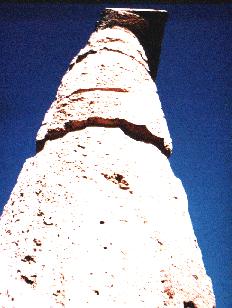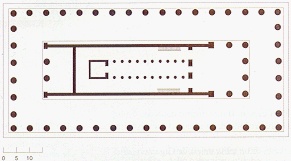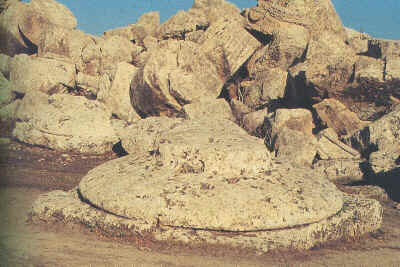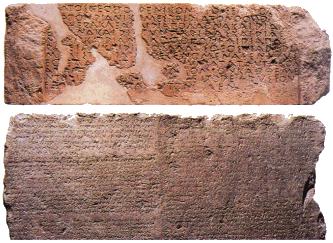|
 Two stumps
of lonely columns placed on the base constitute the remains of the temple
which still charme us because to them are connected important memories of
the city. Two stumps
of lonely columns placed on the base constitute the remains of the temple
which still charme us because to them are connected important memories of
the city.
The dedicatory inscription (the famous Selinuntine Table) testifies that
the building was consacrated to Zeus.
It was the pride of Selinuntines who built it as a
thanksgiving offering to Zeus, the most important god of Selinuntine
Pantheon, as a victory monument.
The temple was one of the most magnificent in ancient times for its size.
Local peasants called it "the Giant's Pilasters"
and the surviving colunn "the old woman's spindle".
The immense rectangular platform, today free from the appalling ruin, is
113,34 m. long and 54,05 m. large, with an area of 126,027 square metres,
and is more than 30 m, high.
With its eight columns on the fronton and seventeen on
each long side, is neither too narrow nor too large, and precedes in time
the scheme of Parthenon in Athens, which expresser perfectly the hellenic
ideal. Entering this temple, the feeling of magnificence must have surely
been peerless.
 The
diameter of the bases of the columns is 3,41 m., 1,91 m. on the top. They're
16,27 m. high and their circonference is 16,70 m. The area of the abacus
is more than 16 square metres. The
diameter of the bases of the columns is 3,41 m., 1,91 m. on the top. They're
16,27 m. high and their circonference is 16,70 m. The area of the abacus
is more than 16 square metres.
The cella (naos) is 65, m. long and 19,81 m. wide, and was divided by the
aisle of the temple, decorated with a double row of 10 monolithic columns,
preceded by a simple "in antis" hall decorated with 6 columns,
and provided with a chapel designed to lodge the statue for god's cult and
followed in the back by a two columns vestibule (opisthdomos). Two stairs
leaning to the walls led to the garret. The building had probably an
unroofed cella and therefore was called "ipetrale". E.M.
Pouqueville writes that the temples consecrated to Jove to the Sun and to
the Moon had to be doric and unroofed.
 The
construction, started about in 530 B.C., tells Diosorus Siculus, had not
been finished when HannibaI sacked the city in 409 B.C.. The temple wasn't
really finished, because many columns are still without flutes and we know
that this work was executed after the drums constituting the columns were
set up and the arrangement of the capital. Like all the others, this
temple is orientated eastwards. The
construction, started about in 530 B.C., tells Diosorus Siculus, had not
been finished when HannibaI sacked the city in 409 B.C.. The temple wasn't
really finished, because many columns are still without flutes and we know
that this work was executed after the drums constituting the columns were
set up and the arrangement of the capital. Like all the others, this
temple is orientated eastwards.
This building offers the uncommon possibility of observing how styles and
techniques changed during 121 years of construction, so that it shows an
archaic face in the eastern side and a classic one in the western side.
Jove, god's and men's father and king, who, with a gesture, makes the
universe tremble, is the genius who animates the vault of heaven. People
thought that life, strength, glory, authority, the beneficial rain, the
spontaneous vegetation derived from him.
 Mount
Olympus, covered by clouds, was its home. Mount
Olympus, covered by clouds, was its home.
He guarded oaths because they contributed very much to keep order, and he
punished the perjurers. The sacred duty of hospitality was also protected
by Jove and on his name geggars and foreigners introduced themselves; and
he punished anyone who neglected to welcome and give hospitality to them.
|
 Two stumps
of lonely columns placed on the base constitute the remains of the temple
which still charme us because to them are connected important memories of
the city.
Two stumps
of lonely columns placed on the base constitute the remains of the temple
which still charme us because to them are connected important memories of
the city. The
diameter of the bases of the columns is 3,41 m., 1,91 m. on the top. They're
16,27 m. high and their circonference is 16,70 m. The area of the abacus
is more than 16 square metres.
The
diameter of the bases of the columns is 3,41 m., 1,91 m. on the top. They're
16,27 m. high and their circonference is 16,70 m. The area of the abacus
is more than 16 square metres. The
construction, started about in 530 B.C., tells Diosorus Siculus, had not
been finished when HannibaI sacked the city in 409 B.C.. The temple wasn't
really finished, because many columns are still without flutes and we know
that this work was executed after the drums constituting the columns were
set up and the arrangement of the capital. Like all the others, this
temple is orientated eastwards.
The
construction, started about in 530 B.C., tells Diosorus Siculus, had not
been finished when HannibaI sacked the city in 409 B.C.. The temple wasn't
really finished, because many columns are still without flutes and we know
that this work was executed after the drums constituting the columns were
set up and the arrangement of the capital. Like all the others, this
temple is orientated eastwards. Mount
Olympus, covered by clouds, was its home.
Mount
Olympus, covered by clouds, was its home.